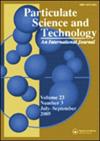Heat transfer study of water and air-based nanofluids with Al 2 O 3 nanoparticles in a circular pipe using a multiphase approach
IF 1.5
4区 工程技术
Q3 ENGINEERING, CHEMICAL
引用次数: 0
Abstract
AbstractThe current work investigates the thermal characteristics of nanofluid flow (water and air as base fluids with Al2O3 nanoparticles) in a circular pipe at constant heat flux. Numerical simulations were performed using the Eulerian-Euleian two-phase model with an RNG k−ε turbulent model with enhanced wall function. Results showed that the two-phase approach reduced the error by about 3–5% in the prediction of the average heat transfer coefficient. Within the range of a volumetric fraction of nanoparticles from 1 to 5% and inlet velocity from 10 to 25 m/s, heat transfer performance increased significantly compared to pure fluid flow. For water, the particle motion from the wall to the center of the pipe was empowered by thermophoresis in addition to higher turbulent kinetic energy leading to a profit index of about 3.5, while for air; the Brownian motion of particles increased the viscosity and thermal conductivity near the wall leading to profit index of about 240 indicating high amount of heat transfer. For both fluids, the heat transfer effectiveness ratio increased at a higher volume fraction of nanoparticles (3.5 for water-based nanofluid and 140 for air-based nanofluid). These values indicate promising effects of nanoparticle addition, especially for air, where the volume fraction had a much more significant effect than water.Keywords: NanofluidAl2O3 nanoparticlesEulerianheat transferNusselt number Disclosure statementNo potential conflict of interest was reported by the author(s).基于多相法的水基和气基纳米流体与氧化铝纳米颗粒在圆管内的传热研究
摘要本文研究了纳米流体(以水和空气为基础流体,含Al2O3纳米颗粒)在恒定热流密度下在圆管内流动的热特性。采用欧拉-欧拉两相模型和增强壁面函数的RNG k−ε湍流模型进行了数值模拟。结果表明,两相法对平均换热系数的预测误差减小了3 ~ 5%。当纳米颗粒体积分数为1 ~ 5%,进口速度为10 ~ 25 m/s时,换热性能明显高于纯流体。对于水,除了更高的湍流动能外,热泳动还增强了颗粒从管壁到管心的运动,导致利润指数约为3.5,而对于空气;颗粒的布朗运动增加了壁面附近的粘度和导热系数,导致利润指数约为240,表明传热量很大。对于这两种流体来说,纳米颗粒体积分数越高(水基纳米流体体积分数为3.5,空气基纳米流体体积分数为140),传热效率比就越高。这些数值表明,纳米颗粒的加入有很好的效果,特别是对于空气,其中体积分数的影响要比水显著得多。关键词:纳米流体al2o3纳米颗粒欧拉传热努塞尔数披露声明作者未报告潜在的利益冲突。
本文章由计算机程序翻译,如有差异,请以英文原文为准。
求助全文
约1分钟内获得全文
求助全文
来源期刊

Particulate Science and Technology
工程技术-工程:化工
CiteScore
4.40
自引率
4.00%
发文量
86
审稿时长
12 months
期刊介绍:
Particulate Science and Technology, an interdisciplinary journal, publishes papers on both fundamental and applied science and technology related to particles and particle systems in size scales from nanometers to millimeters. The journal''s primary focus is to report emerging technologies and advances in different fields of engineering, energy, biomaterials, and pharmaceutical science involving particles, and to bring institutional researchers closer to professionals in industries.
Particulate Science and Technology invites articles reporting original contributions and review papers, in particular critical reviews, that are relevant and timely to the emerging and growing fields of particle and powder technology.
 求助内容:
求助内容: 应助结果提醒方式:
应助结果提醒方式:


